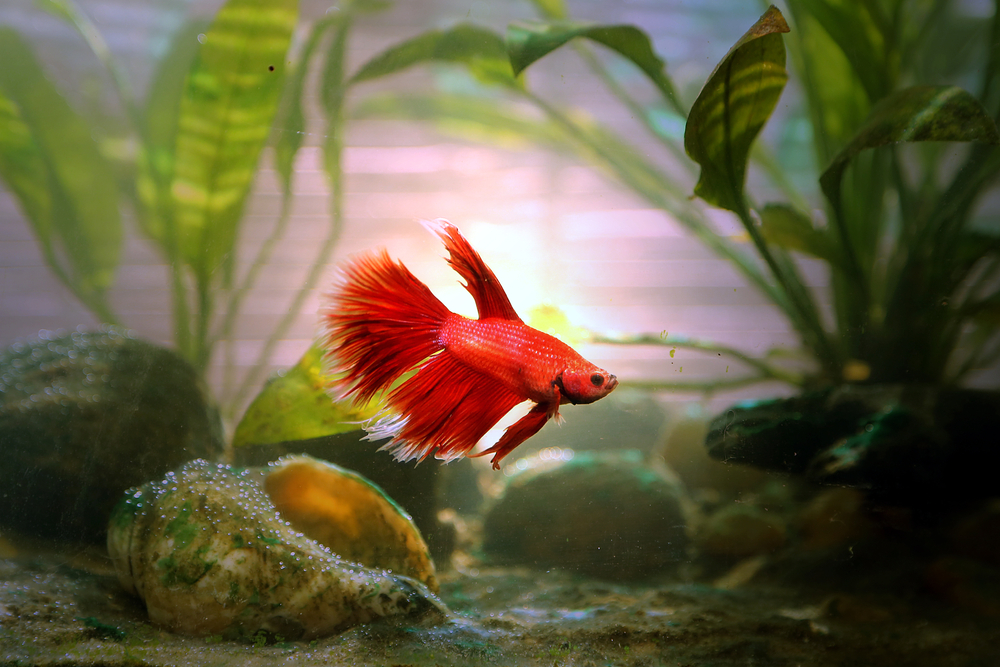Flare-ups—we all have them, don’t we? Sometimes, people are just in a testy mood and may flare up at the slightest provocation, leaving you wondering what on earth is the matter. But as confusing as it may be when people seemingly randomly fly off the handle on you, it can be even more so to see your betta fish do the same.
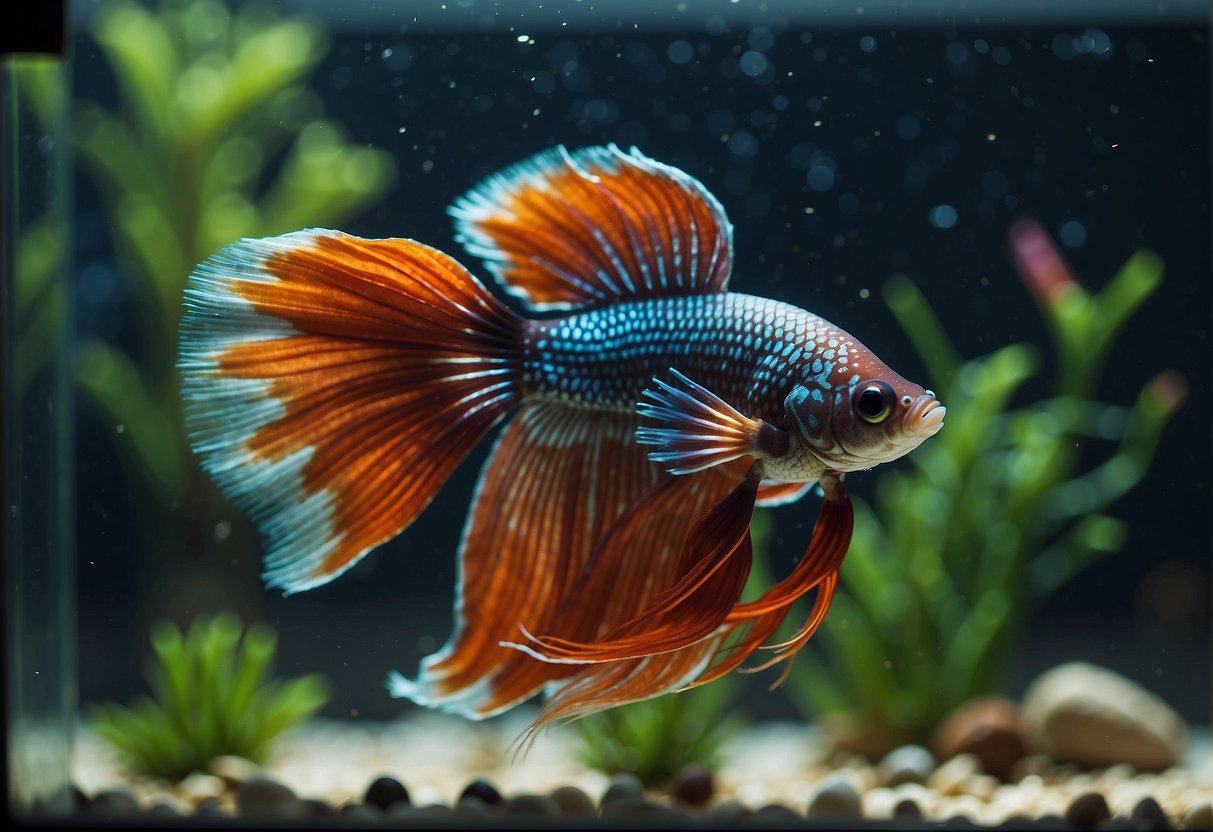
Betta fish tend to flare up literally, and when they do, it’s easy to tell what it means. Sometimes, it’s clearly in reaction to something, such as a tankmate who doesn’t know who’s boss; other times, there’s no obvious provocation, and it may appear that your betta is off their rockers. But, I assure you, they’re almost certainly not.
There are always underlying reasons for a flare-up, and understanding what those are is vital in calming down your betta fish and making sure they are generally happy. So, join me, and let’s talk about betta flare-ups, why they happen, and what to do about them.
Contents
Understanding Betta Flaring
Flaring is a very easily recognizable behavior in many animal species. In betta fish, it involves spreading their gills and fins, thus making themselves appear bigger and more intimidating. Why do they do this, though? Let’s explore the reasons in this section.
Understand the behavior of your betta fish more from these other related posts:
- How Do I Know If My Betta Fish Is Happy?
- What to Do if Your Betta Fish is Pregnant
- Do Betta Fish Like Music?
Reasons for Flaring
Flaring is typically used as an aggressive display to establish dominance over a territory. The sight of another male is the most common trigger for this display since another male in a betta’s territory is often seen as an invader. It tells the other male to back off without having to fight them.
A male betta can also flare when he sees a female one. While the reason for such instances is technically to show strength, the motive is not to scare but to impress the female. Still, both of these instances are signals to another betta. Sometimes, your betta can flare for you as a sign of distress, which signals that you need to check for stressors in the aquarium.
One important thing to note is that some betta fish flare more frequently than others. Some flare very frequently, while others rarely do so. The variety of reasons for flaring and the conditions that influence it are duly taken into account, and it’s clear that different individual fish have different temperaments.
Flaring as Communication
Male bettas are known to flare to communicate a variety of messages. This can range from showing their strength to potential mates, to warding off other males from their territory. Flaring can serve as a sign for owners, indicating that their fish might be feeling stressed or threatened, prompting a check for stressors in their environment.
Male vs. Female Flaring
Among betta fish, males tend to flare the most, given their overtly territorial and aggressive nature. This aggressive display is their primary way of establishing deterrence and pecking orders. Female betta, being way less aggressive, are less prone to flaring up. They tend to establish pecking orders by less aggressive means.
Common Triggers of Flaring
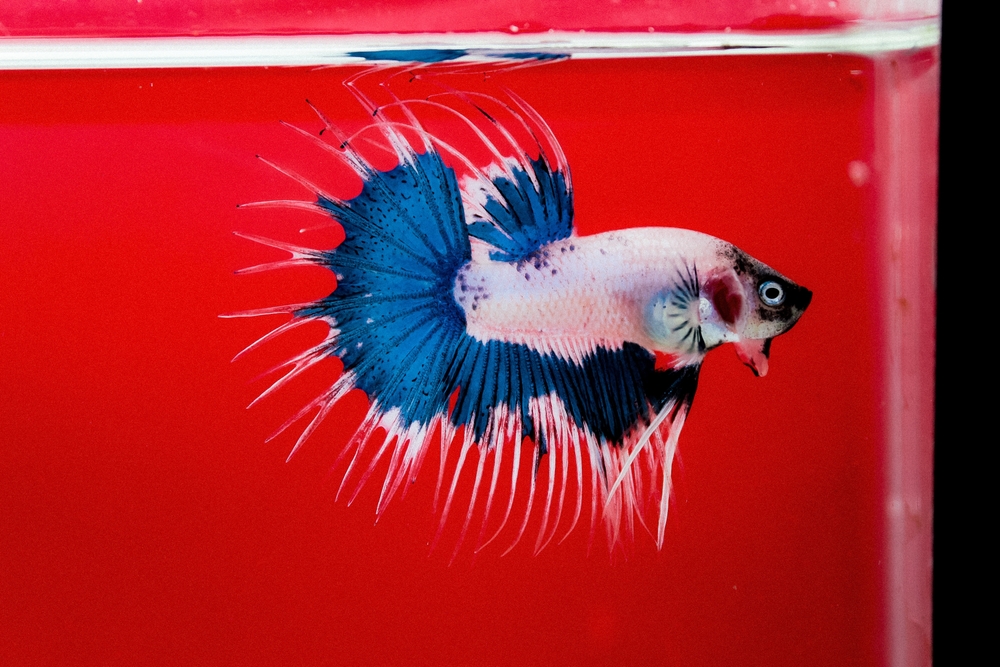
Many things trigger a betta fish to put on this inflated display, often disturbances around them. Let’s briefly go over these triggers.
Reflections in the Tank
Few species are known to recognize themselves in a mirror; Betta Splendens isn’t one of them. So, when your betta sees its reflection in the glass of your aquarium, it thinks another fish is in its space and flares up, attempting to scare it off.
Unfortunately, the reflection flares right back, so the stand-off may go on for a while, potentially for as long as the betta can still see the “other” one.
Interaction with Tank Mates
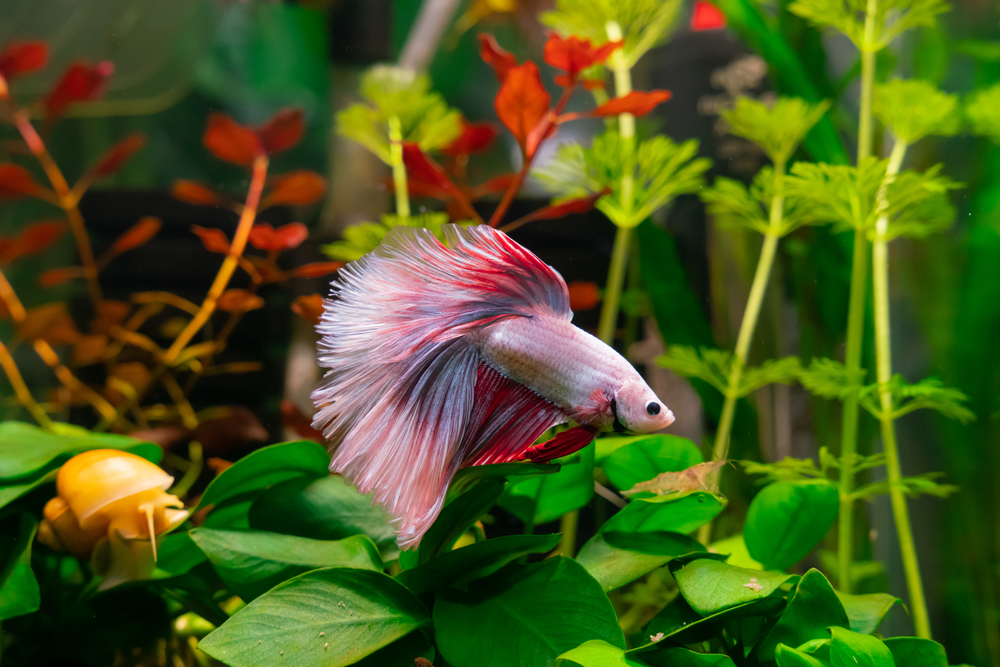
As I mentioned before, flaring is a communicative display for bettas. Other organisms in the same aquarium as your betta can trigger a flaring response, either as a deterrence or as a sign of intent to mate (especially when the other organism is another betta).
If your betta constantly flares at its tank mates, it’s a sign the situation is likely stressful for your pet, and you may need to reconsider the current housing arrangements.
Changes in Environment
Bettas are sensitive to their environment, and even minor changes can cause them stress. Factors such as shifts in lighting, the introduction of new decorations or plants, variations in water parameters, vibrations, or loud activity in the house can all serve as external stimuli that provoke flaring.
Creating a Betta-friendly Habitat
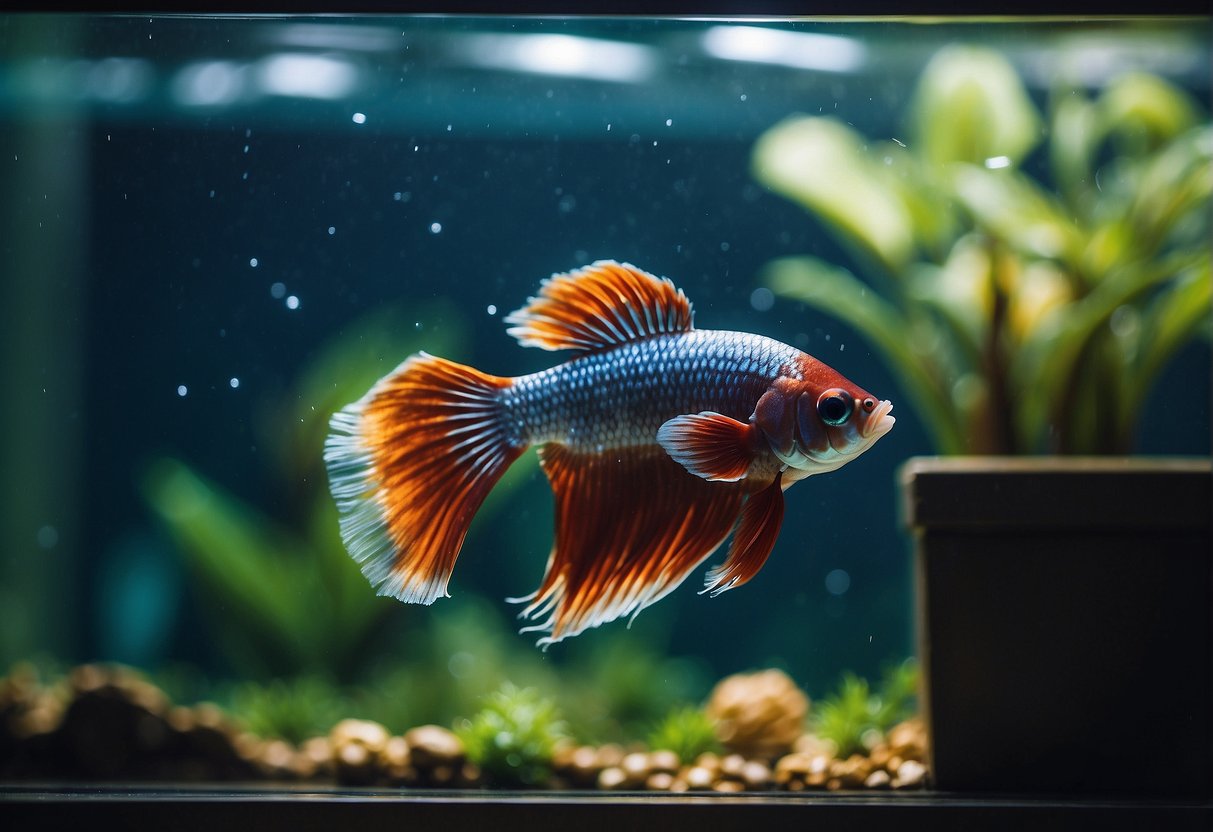
Stress, confrontation, and show-offs are the reasons why bettas flare. In show-off scenarios, your betta is clearly trying to impress a potential mate, which is nothing to worry about.
However, flaring due to stress or confrontation isn’t good, so you need to do all you can to prevent such situations. You can do that by setting up an ideal habitat for your betta, including all the right tank conditions.
Tank Setup and Decor
You want your betta to have enough space and not feel claustrophobic. That means you want to ensure the aquarium size is suitable—at least 5 gallons—to provide ample swimming space.
The internal decor is also essential, as it can make or break your attempt at making your betta comfortable. Objects with sharp edges can injure the fish and are a bad idea.
By contrast, plants, either live or silk, add to the aesthetic of the habitat and provide hiding spots for your Betta to explore and play about in. Speaking of hiding spots, smooth-surfaced pebbles and a few rocks with no sharp edges are advisable.
Importance of Hiding Places

I understand the vital role that hiding places play in a Betta’s sense of security. To cater to this need, I incorporate caves or decorations that serve as hiding spots. This not only helps reduce stress but also gives my Betta private areas to rest and retreat to when they feel the need.
- Caves/Decorations: Must-have for privacy
- Layout: Strategic placement for easy access
Lighting and Reflection
The quality and quantity of lighting are also important factors to consider and manage. Correct lighting and minimizing reflections will create a less spooky environment and prevent your betta from flaring unnecessarily.
You should ensure the lighting is not too intense and that the tank is positioned away from direct sunlight to avoid any temperature spikes. Additionally, you need to check for and minimize reflections within the aquarium regularly. After all, you don’t want your betta seeing and flaring up at its own misidentified reflection.
Maintaining Water Quality

Ensuring pristine water conditions is another crucial step if you don’t want your betta stressing out and flaring up regularly. After all, poor water quality can lead to heightened stress levels and a compromised immune system, which are the ideal water parameters for betta fish.
- Temperature: between 76-81°F (24-27°C)
- pH: 6.5 – 7.5
- Ammonia/Nitrite: 0 ppm
- Nitrate: <20 ppm
Regular water changes and monitoring with a reliable testing kit should also be part of your routine to maintain the ideal water quality.
Providing Proper Nutrition
It should go without saying that your betta fish will be cranky less frequently if well-fed. So, to get the best results, here are some suggestions on what to feed them.
| Day | Food Type | Benefits |
| Monday | High-quality betta pellets | Complete nutrition; enhances coloration |
| Wednesday | Frozen or live brine shrimp | Encourages hunting behavior; rich in protein |
| Friday | Freeze-dried bloodworms | High in protein; provides enrichment |
Crucially, you should maintain a consistent feeding schedule and portion control to prevent overfeeding and avoid potential health concerns.
Betta Territorial Behavior

I understand that betta territorial behavior is a critical aspect of their natural instincts, particularly in how they interact with others in their environment.
Male betta fish tend to be highly territorial, displaying this instinct through flaring and other aggressive behaviors to defend their space. Female bettas can also show territorial tendencies, although this often manifests differently than in males.
Managing Aggression in Community Tanks
If you’re keeping a community of bettas in one aquarium, it had better be a really big aquarium. But also, you should be prepared to mind and manage the complications that arise when multiple bettas share a tank.
It is just objectively a bad idea to put male bettas in a community tank, so you shouldn’t even try that. It’s better to go with the females as they offer the betta aesthetic with much less potential for aggression.
That said, when setting up this betta sorority, understanding the nuances of female betta territorial behavior is key. Female bettas are less aggressive and territorial than males, but they still like territory and can fight over it.
So, again, your aquarium had better be really spacious to house them. Additionally, you should have many plants and smooth rocks in the tank, as these tend to serve as natural barriers and reduce the incidence of invasions and resultant fish fights.
Identifying and Treating Common Betta Ailments
One reason your betta might flare that I haven’t quite touched yet is illness. There are other indicators of illness, as we will soon see, but betta can sometimes flare when sick, so let’s talk about that and what to do about it.
Recognizing Symptoms of Disease
When I inspect my betta fish, I look for a few key indicators that might suggest an ailment:
- Ich (White Spot Disease): Tiny white spots, resembling sugar grains, on skin and fins.
- Fin Rot: Tattered or discolored fins, often stemming from a bacterial or fungal infection.
- General Health: Lethargy, loss of color, reduced appetite, or abnormal swimming behavior.
It’s crucial to know that a strong immune system in betta fish can stave off many conditions. However, when they do fall ill, it’s often due to bacterial infections or parasites that capitalize on compromised health.
Effective Treatment Methods
Once you’ve identified a disease, here are some recommended treatment protocols for each:
- Ich: Gradually increase tank temperature and apply aquarium salt or a medication specifically for ich.
- Fin Rot: Ensure clean water conditions, consider aquarium salt, and, in severe cases, administer antibiotics proven to combat fin rot, such as erythromycin and tetracycline.
While treating any illness in your betta, you should also pay particular attention to water quality and tank maintenance, as a clean environment supports their immune system and overall health. When parasites are the issue, you may use anti-parasitic medicines, administering the dosages precisely per the instructions to avoid overdose.
Breeding and Reproductive Behavior
As you already understand, flaring is also part of betta fish’s reproductive display. And, as I said before, it’s nothing you need to worry about. However, one thing you can do is ensure a suitable environment for such reproductive exercises.
Understanding Betta Courtship
Courtship between male and female bettas is a delicate dance, poised between aggression and allure. First, the male betta displays an aggressive response meant to show dominance, often flaring his gills and spreading his fins to entice the female and ward off rivals.
Flaring also indicates the vigor and health of the male to the female. The female’s readiness is indicated by vertical stripes and a swollen belly, full of eggs. I’ve observed the courtship behavior advancing as the female inspects the bubble nest, signaling approval and readiness to mate.
Posture changes, with the male wrapping around the female, intensify the intricate mating ritual, ensuring the release and fertilization of eggs. Afterward, the male typically becomes solely responsible for safeguarding the eggs within the bubble nest, often exhibiting even more aggressive guarding behaviors until the fry hatch.
Creating an Optimal Breeding Environment
The ideal conditions for breeding bettas include adequate space in at least a 10-gallon tank. The water should also be warm (between 78 and 80 degrees Fahrenheit) and slightly acidic to alkaline (pH level around 7.0).
If the conditions are right, the male will be comfortable to mate, and they will show that by constructing a bubble nest for the eggs that may be fertilized later.
Frequently Asked Questions

Let’s explore some common questions that might shed light on this behavior.
What causes a betta fish to flare without apparent stimuli?
When bettas flare without a clear cause, it could be a response to subtle changes in their environment that aren’t immediately obvious to us. Minor fluctuations in water temperature or chemisty, for instance, could be potential triggers.
Could a betta’s reflection trigger flaring even if nothing else is visible?
Yes, bettas are known to mistake their own reflection as another fish invading their territory. They may flare at the glass of their tank when they see their reflection, thinking it’s a competitor.
Are there signs that indicate a betta fish is flaring due to discomfort?
Additional signs such as frequent hiding, reduced appetite, or erratic swimming could indicate discomfort in bettas. If these behaviors accompany flaring, your betta might indicate stress or discomfort.
Is it normal behavior for bettas to flare frequently with no clear target?
While occasional flaring is normal betta behavior, frequent flaring without a clear target might suggest stress or a need for environmental enrichment. To minimize stress, it’s important to ensure bettas have a stimulating environment.
How can I determine if my betta is flaring out of aggression or fear?
Observing context and body language can give clues; aggression is often directed towards other fish or perceived invaders, while fear-induced flaring might be accompanied by attempts to hide or escape.
What environmental factors could contribute to a betta seemingly flaring at nothing?
Several environmental factors can lead to a betta flaring seemingly at nothing, including introducing new decorations or new tank equipment or even having their tank in a high-traffic area where they may feel threatened by frequent movement.

Ian Sterling, founder of Fishlab.com, began his aquarium journey over 30 years ago, driven by a deep fascination for fish and their diverse personalities. His website, Fishlab.com, is dedicated to making fishkeeping accessible and enjoyable, offering beginner-friendly guidance, expert insights, and a community for aquarists to connect and share experiences.


